One of Australia’s most successful show riders, Jess Stones has won too many titles to count, including the much coveted Garryowen Equestrienne Turnout. So who better to ask about show preparation?
What’s the one thing you must have when you’re heading off to a show?
My makeup box! We use Judges Choice makeup and plaiting products. So you’ve got your black and brown leg and eye makeup, and white cover cream. Then there’s the plaiting thread, elastics and my shine sprays, plaiting sprays and quarter mark sprays. Taking your own makeup box is a really key thing.
What are the most important things to train for at home?
There’s not one thing that out weighs anything else, but something a lot of people forget about with show horses is the walk. It’s an important part of your training ride-not just the trotting, cantering and fancy stuff. Also, try and ride your horse in an outside area. If you’re riding in an enclosed arena all the time, when you get to a show and you’re suddenly out in an open space your horse doesn’t know how to follow its nose because it’s used to following a wall. I also think that with preparation and training-especially if you’re starting out with a young horse, or a horse that’s new to showing–that it’s really important to ride your horse in its complete show gear at home.

Jess and Mikimoto won the 2019 Col A. V. Pope Cup the day before they triumphed in the prestigious Garryowen
(Image by Lisa Gordon).
Show riding attire: what are the most important items to get right?
Everything’s important to get right, but it can definitely be a big spoiler if you have a poorly fitting jacket, or one that’s not appropriately styled according to your event-whether you’re in show hunter, or rider classes. It’s the same with breaches. Go for good fit and an appropriate colour and not over the top! Less is definitely more. Things are starting to come back to a more traditional and tasteful look, so that’s nice!
What are your favourite quarter mark patterns and why?
We assess and decide what type of patterns we put on each horse according to its hindquarter build and structure, its rump, and how round, plump or angular it is. Putting on certain types of patterns will enhance it and make it look its best. So it really depends on the type of horse. In the hunters it’s fairly basic because it’s just stripes on the rump, and then shark’s teeth and a moon if needed. Whether you want to fill up the space or leave it more open depends on the type of horse and how you’re wanting to enhance it.
What preparations can you use pre-event so your horse looks its best?
First, I’d like to stress that to me, a healthy, gleaming horse starts on the inside. So that comesback to good diet and exercise. Prior to a show, our horses are all shampooed and conditioned with Judges Choice products. We generally put on a hot oil rinse to give extra shine to the coat and take out any dead hair. I use a taming wax to plait the mane, and for the tails I use Showsheen Absorbine before brushing and putting in their false tails. I might only use water to prepare their rumps for quarter marks, and then use Judges Choice Quarter Mark spray over the top.

Champion Newcomer Ridden Hunter Pony at the 2021 Equestrian NSW Southern Cross Show Horse Spectacular
(Image by Lisa Gordon)
What basic coats should riders have? Should you match your coat colour to your horse?
Always go for something tasteful, well fitting, and appropriate for your event. There’re a lot of Australian companies that aren’t ridiculously expensive and have a good range, so shop around. When it comes to matching your jacket with your horse’s colour –yes and no. It would depend on whether you’re talking hunter or open. I have quite a few jackets thanks to Just Neigh, my sponsor, but I don’t really change my jackets according to the colour of the horse. If I’m at a show like the Grand Nationals for example, where I’ll ride a grey, a chestnut, a brown, a black, even a palomino pony that I show, I wear the one jacket across all my horses.
Numnahs, half pads or something else – what do you prefer in the ring?
All of our horses wear a full numnah, but I’m definitely not opposed to a half pad. I designed a numnah with our sponsor Trailrace that’s only visible if you want it to be. It looks like a half pad but it’s actually a full numnah that’s hidden under the saddle. From my point of view, it’s more about the horse’s comfort. I couldn’t imagine wanting the leather of a saddle flaprubbing on my side without any protection. So by all means put a sheepskin all the way around if you like that visual, but for me it’s the look of the half pad which is actually a full numnah but not visible under the flap of the saddle.
A double bridle or a snaffle – how do you decide?
I let the horse tell me when they’re ready for a double. My view is if the horse is good enough, it’s good enough no matter what bit is in its mouth. Generally, bring your horse out in a newcomer year in a snaffle. Towards the end of the year you might have a couple of events where you introduce the double. Then go back to a snaffle – just gently wean them into it. That said, some judges are prejudiced towards a double. There’s nothing nicer than seeing a polished look, an elegant rider and a beautiful double bridle, but I think whatever is right for the horse’s comfort and happiness comes first. That to me is more important than whether it’s got two reins attached to its bit or one.
Jess and Rhys Stones of J & R Equestrian have represented Australia nationally and internationally, and produce performance horses of the highest quality.
Visit www.facebook.com/jandreques/ for details



